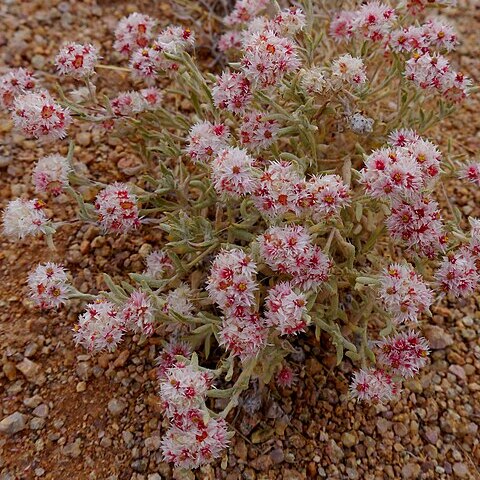Perennial herb sometimes flowering in seedling stage, taproot stout, woody, crown becoming woody at base with age, main branches ±150-450 mm long, subsimple to profusely branched, prostrate, decumbent or erect, thinly woolly becoming floccose, leafy. Leaves (4-)10-35 x (1-)1.5-8(-12) mm, linear, oblong-lanceolate, lanceolate, oblanceolate, occasionally narrowly to broadly obovate or spathulate, acute, subacute or obtuse, mucronate, base narrowed, half-clasping, both surfaces thickly to thinly greyish-woolly, often yellowish when young. Heads homogamous, campanulate, ±(4-) 5-6 x 3,5-4(-6) mm, many in tight globose clusters ±15-20 mm across at the tips of the branchlets, surrounded by woolly leaves mostly longer than the compound head. Involucral bracts in ±6 series, subequal, slightly exceeding the flowers, loosely imbricate, very acute to acuminate, radiating, shining, pellucid, silvery white, inner in particular often suffused or tipped pink or crimson, rarely with flecks of colour, tips sometimes subopaque. Receptacle with pit margins shortly produced, or nearly smooth. Flowers 18-50, yellow, tipped red. Achenes 0.75 mm, elliptic, with myxogenic hairs, or rarely glabrous. Pappus bristles many, about equalling corolla, scabrid, bases cohering by patent cilia. Flowering recorded throughout the year, but mainly between June and September.
More
A herb or shrub. It is small and straggling. It grows up to 90 cm high. It has a taproot. The branches are slender. The leaves are scattered and spreading. They are covered with grey woolly hairs. The leaves are narrow and blunt. The edges curve back. The leaves are 1.5 cm long by 2 mm wide. The flowers are at the ends. They are in compact round heads. These are 1.5 cm across. They are pink.
Prostrate, decumbent or erect perennial herb, 150-450 mm tall. Leaves (4-)10-35 x (1.0-) 1.5-8.0(-12.0) mm, linear, oblong-lanceolate, lanceolate, obovate or spathulate, both surfaces greyish woolly, often yellowish when young. Heads campanulate, many in tight globose clusters. Flowers yellow, red-tipped; involucral bracts silvery white, inner often suffused or tipped pink or crimson.

